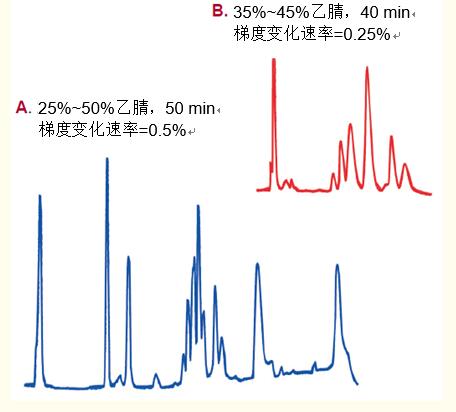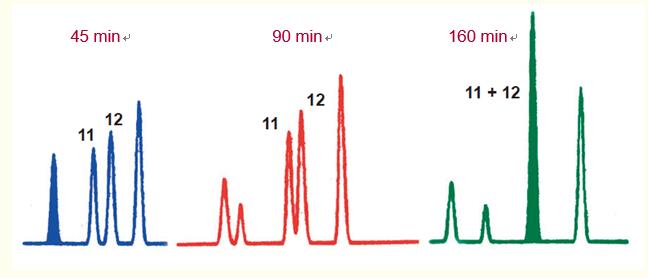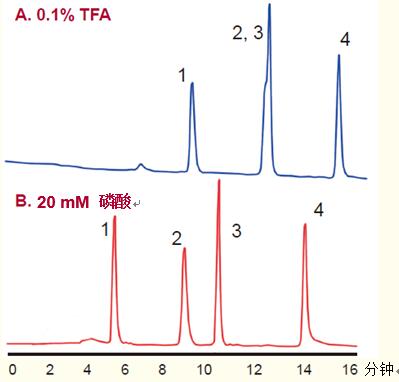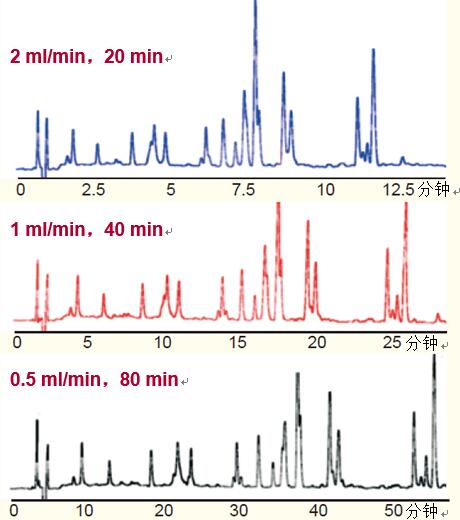Mobile phase selection in liquid phase analysis of protein/polypeptide
An organic solvent can elute proteins adsorbed at the hydrophobic interface (Figure 14).
During the gradient elution, when the amount of organic solvent reaches a specific concentration for each protein, the protein desorbs from the hydrophobic interface and continues down the column to elute from the column.
Figure 14. When the concentration of the organic modifier reaches a certain value, the protein elutes from the hydrophobic interface.

Acetonitrile. The most common organic solvent used in the reverse phase chromatography of peptides is acetonitrile. Why choose acetonitrile?
Acetonitrile is volatile and easily removed from the sample.
Acetonitrile has low viscosity and low column pressure.
Acetonitrile has a shorter UV absorption cutoff wavelength.
Acetonitrile has long been used in separation applications.
Isopropyl alcohol. Isopropanol plays an important role in the chromatographic separation of polypeptides. Although isopropanol has a large viscosity (which increases columnar pressure) and is rarely used as an organic modifier alone, it plays an important role in improving the recovery of some polypeptides, especially strong hydrophobic proteins.
In such cases, isopropanol is added at a constant concentration of 1% to 5% to increase the recovery or elution of the hydrophobic polypeptide.
Other organic modifiers. Organic modifiers such as methanol or ethanol are rarely used unless a strong hydrophobic protein is isolated. In addition, due to its low toxicity, ethanol is also used for large-scale purification of proteins.
Gradient elution. The elution of the polypeptide is almost always carried out by a gradient elution method, and when the gradient elution method is used, the relative concentration of the organic solvent is gradually increased.
When the concentration of the organic modifier rises to the specific concentration required for desorption, the protein and polypeptide elute from the column. As shown in Figure 15, the slower the rate of change (concentration) of the organic modifier, the higher the resolution of these protein subunits.
In this example, a gradient change of 0.25% per minute significantly improves resolution compared to a gradient rate of change of 0.5% per minute.
A separation of several insulins at a rate of gradient change of 0.15% per minute is shown in Figure 1 of the protein/polypeptide retention mechanism . The resolution is maximized when eluting at a gradient rate of 0.05% per minute.
Figure 15. In general, reducing the rate of change in organic solvent concentration increases resolution.
A. Cytochrome c subunit
B. Reproduction of the middle segment of chromatogram A.
Column: C4 wide-bore column, 4.6 x 250 mm

When reducing the rate of gradient change and increasing the resolution, the analysis time required must be as short as possible.
However, the rate of gradient change is important in optimizing the resolution of proteins and peptides.
Sometimes, when the rate of gradient change is reduced, the peptide exhibits specific behavior (Figure 16).
The resolution sometimes does not increase as expected, but instead decreases, causing co-elution, and even the elution order will be reversed.
In the example of Figure 16, polypeptides 11 and 12 exhibited the best separation when the elution time was 45 minutes.
When the elution time was increased to 90 minutes, the resolution between polypeptides 11 and 12 was lowered; and when the elution time was increased to 160 minutes, a coelution peak appeared.
This retention behavior is the result of interactions on the surface of the polypeptide, and the cause of this behavior is currently unclear.
Therefore, when performing polypeptide separation, especially when separating protease hydrolysates, it is important to observe changes in resolution with decreasing gradient gradient.
If the resolution is not increased, but instead decreases, the rate of gradient change must be optimized to maximize the overall resolution.
Figure 16. The resolution between polypeptides sometimes decreases as the rate of change in solvent concentration decreases (increased elution time).
This will result in reduced resolution or the appearance of co-eluting peaks, as exemplified by polypeptides 11 and 12 in the human growth hormone peptide map.
In some cases, the polypeptide may even reverse the elution order.
Sample trypsin hydrolysate of human growth hormone. Part of the peptide map is shown. 
Column: C18 wide-bore column, 4.6 x 150 mm
Eluent: Gradient: 0~60% acetonitrile and water-soluble solvent and 0.1% TFA mixture and organic solvent and 0.08% TFA mixture formed a gradient elution in a certain period of time.
Reversed-phase chromatography of proteins and peptides requires an "ion pair reagent."Ion pairing reagents are added to the mobile phase to achieve good peak shape.
It is currently believed that in the absence of ion-pairing reagents, metallic impurities on the surface of the silica gel are responsible for the poor peak shape of the protein/polypeptide.
Trifluoroacetate. Trifluoroacetic acid (TFA) is the most commonly used ion pairing reagent. Adding a concentration of ~0.1% trifluoroacetic acid to the mobile phase produces a good peak shape on most of the columns (Figure 17).
Decreasing the concentration of TFA can improve the detection sensitivity of LC-MS (see pages 22-25), but due to the presence of impurities on the surface of the silica gel, the peak shape on the silica column may be poor.
However, when using a high purity silica gel column, a low concentration of TFA can be added (Fig. 17A - 0.01% TFA).
Figure 17. Effect of TFA concentration on peak shape and selectivity

Eluent: Add TFA as shown, eluting with a gradient of 20% to 32% acetonitrile (ACN) for 15 minutes.
Sample 1. Angiotensin II 2. Angiotensin III 3. Angiotensin I
Other ion pair reagents. Although TFA is by far the most commonly used ion-pairing reagent, other reagents such as phosphoric acid and heptafluorobutyric acid (HFBA) are sometimes used for protein/peptide separation.
As shown in Figure 18, in some cases, phosphoric acid can separate some polypeptides that TFA cannot separate. Phosphate is typically used at a concentration of about 20-30 mM and a pH of 2 to 2.5. In addition, phosphate buffers are superior to TFA in the separation of some proteins.
Although phosphate buffers typically use lower pH than TFA, phosphate buffers can accommodate higher pH values, providing opportunities for selectivity and resolution changes (see page 17).
The main drawback of using phosphate as an ion-pairing reagent is that phosphate is not volatile and is difficult to remove from the peptide.
In some cases, heptafluorobutyric acid is used as an ion pair reagent for the separation of basic proteins such as histones.
Figure 18. Ion pair reagents other than TFA may produce different selectivity

Conditional column: C18 wide-bore column, 4.6 x 250 mm
Eluent:
A. 4% ~ 40% acetonitrile - 0.1% TFA system, pH = 2, 18 minutes gradient elution.
B. 4% ~ 40% acetonitrile - 20 mM phosphoric acid system, pH = 2, 18 minutes gradient elution.
sample:
Bradykinin
Neurotensin
Bombesin
Octopus salivary gland
The effect of pH on the retention behavior of the polypeptide. Regardless of TFA and phosphoric acid, or other ion-pairing reagents, the reverse phase mobile phase used for peptide separation typically has a lower pH.
At low pH conditions, the carboxylic acid group, the terminal carboxyl group, and the side chains of aspartic acid and glutamic acid are protonated and have only a slight polarity.
Increasing the pH of the mobile phase to 6-7 will ionize the carboxylic acid group and weaken the hydrophobicity of the polypeptide. This will reduce the retention of various polypeptides, but will particularly affect polypeptides containing aspartic acid or glutamic acid (Figure 19).
The retention of the aspartic acid and glutamic acid-containing polypeptides is reduced more than other polypeptides, thereby changing the selectivity. Although increasing the pH of the mobile phase to separate mobile phases is not often used, it can work in specific situations.
Figure 19. The pH of the mobile phase affects the retention of the polypeptide, especially the polypeptide containing acidic amino acid residues (aspartic acid and glutamic acid).

Conditional column: ACE 5 C18-300, 4.6 x 250 mm
Eluent:
A. 20% ~ 32% acetonitrile - 0.1% TFA system, pH = 2, 15 minutes gradient elution.
B. 20% ~ 32% acetonitrile - 10 mM NH4OAc system, pH = 7, gradient elution in 15 minutes.
sample
Angiotensin II
Angiotensin III
Angiotensin I
Flow rate. The flow rate of the mobile phase has little effect on the resolution of reversed-phase high performance liquid chromatography separation.
As shown in Figure 20, the resolution of the polypeptide in the trypsin profile was approximately the same at a mobile phase flow rate of 0.5, 1.0 or 2.0 ml/min.
However, the gradient volume must be constant to maintain consistent resolution.
This requires a reduction in the gradient elution time as the flow rate increases.
System pressure increases as the flow rate increases; system pressure may limit the available flow rate.
In addition, higher flow rates also result in a slight decrease in detection sensitivity, but may increase the solubility of macromolecular or hydrophobic proteins.
Figure 20. The flow rate of the mobile phase has little effect on the resolution of the polypeptide. As the flow rate changes, the total gradient volume must remain constant to maintain consistent resolution.

Conditional column: C18 small column, 4.6 x 250 mm
Eluent: 10%~50% acetonitrile~0.1% TFA system, time, flow rate as shown in the sample β-lactoglobulin trypsin hydrolysate
it is full range of valve seat for the following type :
AAA) YANMAR DIESEL ENGINE
K(D)L, KFL-T, 6MAL-H/T/HT/DT, S165-T/ST/EN,
S185-ST/UT/ET, M200L-UN/SN/EN/M220L-UN/SN/EN / N 330
BBB) DAIHATSU DIESEL ENGINE
PS22/26/ DS18(A)/ DS(B)22/
DL20/22/28/ DK20 / DK 28
CCC) NIIGATA DIESEL ENGINE
6L(M)25BX/6M28AFTE/BX/6M31X/EZ/EX/ 31AFTE /34AGT
DDD) AKASAKA
AH30/AH38/ AH40/D/F/ A31/34/37/41/ DM28/30/33/36/38/40(A)K/ DM46/ UEC37H-HB/ UEC 37/88H
UEC 37LA/ UEC45LA/ UEC52LA/ UEC52HA/ UEC60HA/ UEC60LS/ UEC45HA/115 ALL UET TYPE
EEE) MITSUBISHI (KOBE AND AKASAKA )
45/75C/ 45/80D/ 52/90D/ 52/105D.E/
UEC37H-IIB/ UET37/88HA/UEC45HA.LA/ UEC52HA.LA/ S6B/
ETC
FFF) HANSHIN
6LU(D)26/ 6LU(N)28A/ 6LU(D)32/6LU(D)35/ 6LU(S)38/ 40 / 6LU40/ 6LU46A/ 6LU50A/
6EL30/ EL(S)32 /6EL(S)35/ 6EL38/ 6EL40/ 6EL(S)44/50A/
GGG) MAN B&W
S35MC/L35MCE/L50MCE/ L60MCE/ 40/54A
HHH) MITSUBISHI PURIFIER
SJ700~SJ1800/SJ 2000
III)SULZER
RND 68 RND 76 RD 44
JJJ) MAKITA
GSLH – 633 637 KSLH -633 637
Kkk) PIELSTICK
PC 2-5 PC 2-6
Valve Seat,Exhaust Valve Seat,Hardened Valve Seats,Valve Rubber Seat
ZhouShan HeCheng Machinery Co., LTD. , https://www.hcmarineparts.com